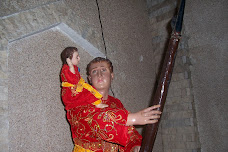

The first hurdle is the idea that he was a dog-headed cannibal. This can be understood in the light of the practice of the time, which was to describe all people outside the “civilized” (Greco-Roman-Persian) world as cannibal, or dog-headed albeit metaphorically. A later generation could then mistake a metaphor or hyperbole for a literal statement.
The man in question is also said to have been assigned to a military unit made up of Marmaritae. The Marmaritae were the independent tribes of Marmarica (now in modern Libya), who would have pushed to the frontier region after Roman settlement. Since he was from a frontier tribe, describing him as being from the land of dog-headed people would have been a literary convention of the day.
The various miracles attributed to him could be explained as ordinary embroidering typical of hagiography, especially regarding saints of the early centuries of Christianity.\
Finally, we have the statements that he was killed in Antioch and his body taken elsewhere by a bishop. St. Christopher could not have been killed in the fourth year of the Emperor Decius, as Decius only reigned for two years, however, before ascending to the throne of the Eastern Roman Empire, Maximinus was known as “Daza” before rising to power. Unfortunately, there is no record of a visit to Antioch by Maximinus in the fourth year of his reign (308). It is, of course, possible that St. Christopher was executed in Antioch during this year by the order of a lower authority; a personal trial before one of the Caesars could be a later embellishment.
Unfortunately, none of this information permits identification of the actual man. CHRISTOPHER is simply greek for “CHRIST-BEARER”, and it can refer, as in the Eastern tradition and in Jacobus de Voragine’s explanation of the name, to St. Christopher’s willingness to “TAKE UP THE CROSS” – a common metaphor for converting to Christianity . “Reprobuz” simply means “wicked person”, so saying that “Reprobuz” became CHRISTOPHER amounts to saying “A WICKED PERSON BECAME A CHRISTIAN”. Furthermore, no place claims to be the burial site of St. Christopher, which would be very unusual for a martyr.
It has been speculated that St. Christopher could be the same man known as “Saint Menas” among the Copts, for whom a 4th century burial site is known but has no verifiable details about his life or martyrdom attached to him. However, there is no conclusive link.
The man in question is also said to have been assigned to a military unit made up of Marmaritae. The Marmaritae were the independent tribes of Marmarica (now in modern Libya), who would have pushed to the frontier region after Roman settlement. Since he was from a frontier tribe, describing him as being from the land of dog-headed people would have been a literary convention of the day.
The various miracles attributed to him could be explained as ordinary embroidering typical of hagiography, especially regarding saints of the early centuries of Christianity.\
Finally, we have the statements that he was killed in Antioch and his body taken elsewhere by a bishop. St. Christopher could not have been killed in the fourth year of the Emperor Decius, as Decius only reigned for two years, however, before ascending to the throne of the Eastern Roman Empire, Maximinus was known as “Daza” before rising to power. Unfortunately, there is no record of a visit to Antioch by Maximinus in the fourth year of his reign (308). It is, of course, possible that St. Christopher was executed in Antioch during this year by the order of a lower authority; a personal trial before one of the Caesars could be a later embellishment.
Unfortunately, none of this information permits identification of the actual man. CHRISTOPHER is simply greek for “CHRIST-BEARER”, and it can refer, as in the Eastern tradition and in Jacobus de Voragine’s explanation of the name, to St. Christopher’s willingness to “TAKE UP THE CROSS” – a common metaphor for converting to Christianity . “Reprobuz” simply means “wicked person”, so saying that “Reprobuz” became CHRISTOPHER amounts to saying “A WICKED PERSON BECAME A CHRISTIAN”. Furthermore, no place claims to be the burial site of St. Christopher, which would be very unusual for a martyr.
It has been speculated that St. Christopher could be the same man known as “Saint Menas” among the Copts, for whom a 4th century burial site is known but has no verifiable details about his life or martyrdom attached to him. However, there is no conclusive link.





No comments:
Post a Comment